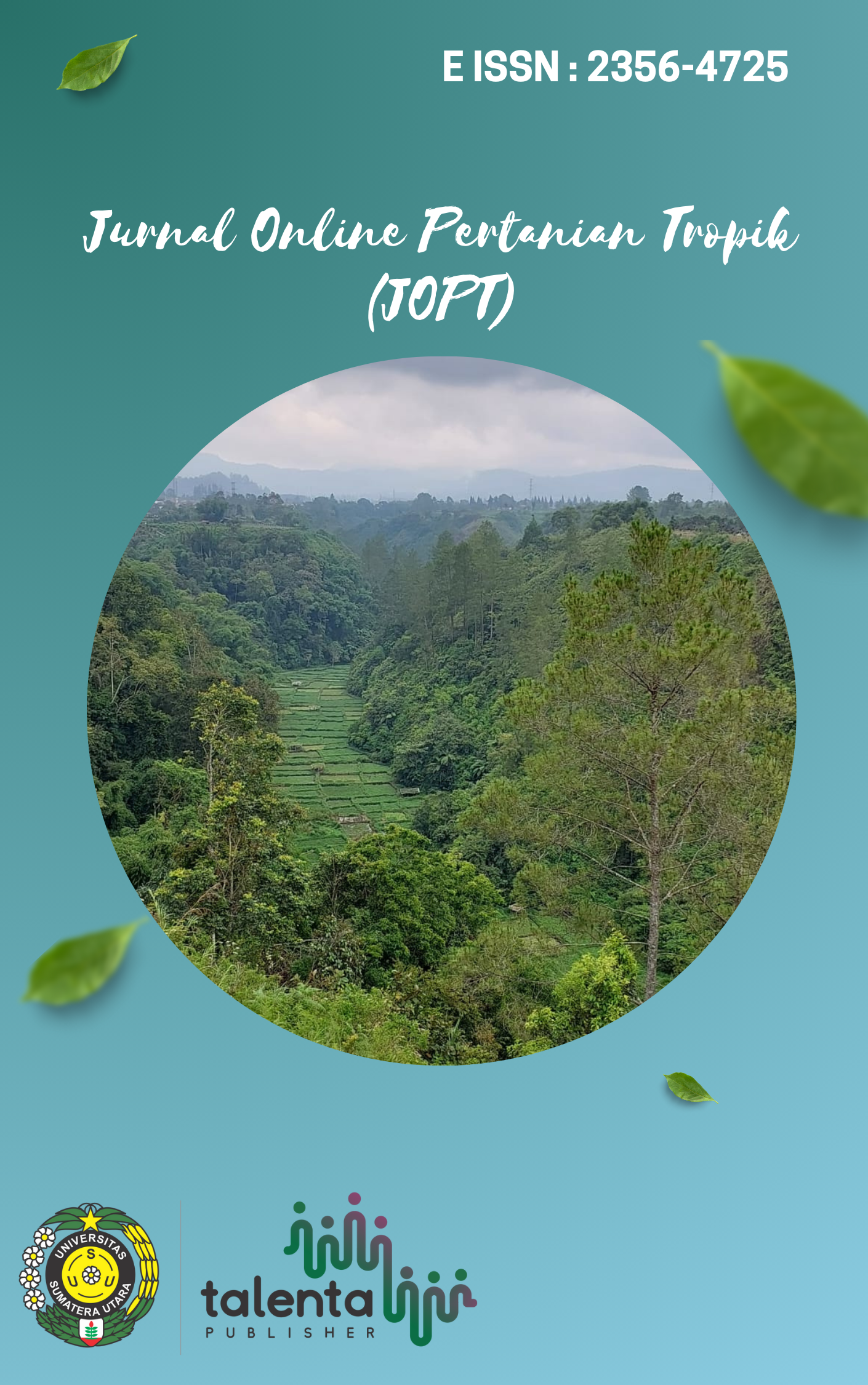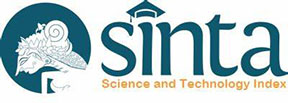Efficacy of endophytic fungi isolated from Azadirachta indica roots against Alternaria causing early blight of tomato
DOI:
https://doi.org/10.32734/jopt.v10i2.11545Keywords:
tomato early blight; Alternaria; Endophytes; Azadirachta indicaAbstract
Many medicinal plants are reported to host a myriad of beneficial endophytic microbes. Among the well-known medicinal plants is Azadirachta indica (Neem; Family Meliaceae), which has gained worldwide importance due to its extensive array of therapeutic and insecticidal qualities. The use of A. indica extracts in the treatment of plant pathogens has been the subject of extensive investigation, but its endophytic microbes as potential biocontrol agents have received very little attention. In this study, the efficacy of endophytic fungi isolated from A. indica roots against Alternaria, which causes tomato early blight, was examined. Isolation and characterization of Alternaria species and endophytic fungi were done in the laboratory using standard procedures. An in-vitro assay of the endophytic fungi isolates against Alternaria was conducted in a complete randomized design in order to determine the percentage zone of inhibition. The colonies of Alternaria isolates were fast-growing, black to grayish-brown, and suede-like. The conidial length from different isolates was statistically significant (p ˂ 0.05) and ranged from 15 μm to 46 μm. The conidial widths were not statistically significant (p > 0.05) and ranged from 8 μm to 15 μm, while the conidial area ranged from 120 μm to 690 μm. A total of seven species of endophytes were isolated from the root of Azadirachta indica: Phoma, Actinomycetes, Chaetomium, Trichoderma, Verticillium, Penicillium, and Fusarium. There was a significant difference in the zones of inhibition (p ˂ 0.05), which ranged from 0.0 mm (Actinomycetes) to 3.44 mm (Trichoderma). These isolates could be used to create brand-new organic antifungal substances that are efficient against a variety of plant fungal pathogens.
Downloads
References
Ahuja, V., and Bhatt, K. (2018). Trichoderma viride (MTCC 800): a potential candidate for agri-horti waste utilization by solid state fermentation. International Journal of Environmental Science and Technology, 15, 2679–2684.
Ajayi, O., Tairu, M., and Akinleye, C. (2018). Growth and Yield of three Varieties of Tomato as Influenced by Staking and Spacing. Proceedings of the 36th Annual Conference of Horticultural Society of Nigeria (Hortson), Lafia 2018 (pp. 120-126). Hortson: National Horticultural Research Institute,.
Akrami, and Yousefi. (2015). Biological control of Fusarium wilt of tomato (Solanum. Biological Forum-An International Journal, 887-892.
Ala, A., Patandjengi, B., and Syam’un. (2018). Effect of Seed Inoculation with Actinomycetes and Rhizobium Isolated from Indigenous Soybean and Rhizosphere on Nitrogen Fixation, Growth, and Yield of Soybean. International Journal of Agronomy, 23-67.
Al-Daghari, R., Maharachchikumbura, S., Al-Moqbali, A.-S., and AlSadi, A. (2020). Fungal Diversity In Leaves And Stems Of Neem (Azadirachta Indica). International Journal of Scientific and Technology Research, 9(6), 793-798.
Alexandrov, V. (2011). Efficacy of some fungicides against late blight of tomato. Bulgarian Journal of Agricultural Sciences, 465-469.
Alvin, A., Miller, K., and Neilan, B. ( 2014). Exploring the potential of endophytes from medicinal plants as sources of antimycobacterial compounds. . Microbiological research, 169(7-8), 483-495.
Amerasan, and Jayakumar, V. a. (2019). Isolation and Characterization of Endophytic bacteria Associated with Chilli Grown in Coastal Agricultural Systems. Indian Jurnal of Biotechnology, 13.
Anastacia, and Wambui, H. (2011). Evaluation of tomato (Lycopersicon esculentum L.)variety tolerance to foliar diseases at Kenya Agricultural Research Institute Centre-Kitale in North. African Journal of Plant Science, 676-681.
Andersen, B., and Thrane, U. (1996). Differentiation of Altemaria infectoria and Alternaria alternata based on morphology, metabolite profiles, and cultural characteristics. Canadian Journal of Microbiology, 42(7), 685-689.
Andersen, B., Krøger, E., and Roberts, R. ( 2001). Chemical and morphological segregation of Alternaria alternata, A. gaisen and A. longipes. . Mycological Research, 105(3), 291-299.
Awada, N., Kassemb, A., Hamed, M., .El-Naggard, A., and El-Fekya, M. (2014). Bioassays guided isolation of compounds from Chaetomium globosum. Journal de Mycologie Médicale, 24(2), e35-e42.
Bae, H., Roberts, D., Lim, H., Strem, M., Park, S., Ryu, C., and Bailey, B. (2011). Endophytic Trichoderma isolates from tropical environments delay disease onset and induce resistance against Phytophthora capsici in hot pepper using multiple mechanisms. Molecular Plant-Microbe Interactions, 24(3), 336-351.
Camlica, E., and Tozlu, E. (2019). Biological Control of Alternaria Solani In Tomato. Fresenius Environmental Bulletin, 28(10), 7092-7100.
Chaerani, Roeland, E., and Voorrips. (2006). Tomato early blight ( Alternaria solani ): the pathogen, genetics, and breeding for resistance. The Phytopathological Society of Japan and Springer 2006, 335-347.
Chatterjee, S., Ghosh, R., and Mandal, N. (2019). Production of bioactive compounds with bactericidal and antioxidant potential by endophytic fungus Alternaria alternata AE1 isolated from Azadirachta indica. PLoS One, 14(4), 214-744.
Chutulo, E., and Chalannavar, R. (2018). Endophytic mycoflora and their bioactive compounds from Azadirachta indica: A comprehensive review. . Journal of Fungi, 4(2), 42-98.
Damalas. (2009). Scientific Research and Essay , 4 (10), 945-949.
Dheeba, B., Niranjana, R., Sampathkumar, P., Kannan, K., and Kannan, M. (2015). Efficacy of neem (Azadirachta indica) and tulsi (Ocimum sanctum) leaf extracts against early blight of tomato. Proceedings of the National Academy of Sciences, 85(1), 327-336.
DÃez, M., and Nuez, F. (2008). Tomato. In Vegetables II . Springer, New York, 249-323.
Dohroo, K. (2016). Antimicrobial Agent for Human Welfare, 220–223.
Dolou, N., Eric, M., and Denise. (2018). Diseases And Pests Associated to Tomato Cultivation in The Locality of Daloa (Côte d’Ivoire). Journal of Advances in Agriculture , 2349-0837 .
Dubey, and Kashyap. (2016). Azadirachta indica: A Plant With Versatile Potential. RGUHS J Pharm Sci, 39-46.
Dun-chun, Jia-sui, and Lian-hui. (2016). Problems, challenges and future of plant disease management:. Journal of Integrative Agriculture ,, 15(4), 705–715.
FAO. (2002). Growth and Physiological Adaptations of Tomato Plants (Lycopersicon esculentum Mill) in Response to Water Scarcity in Soil [2010. Journal of Bio-Environment Control, 19, 1229-4675.
Fayyadh, M. (2019). Biological control of tomato leaf spot disease caused by Alternaria alternata using Chaetomium globosum and some other saprophytic fung. Biological control of Root and stalk rot disease, 1-7.
Hanada, R., Souza, T., Pomella, A., Hebbar, K., Pereira, J., Ismaiel, A., and Samuels, G. (2008). Trichoderma martiale sp. nov., a new endophyte from sapwood of Theobroma cacao with a potential for biological control. Mycological Research, 112(11), 1335-1343.
HCDA, .. (2013). National Horticulture Report 2013. Nairobi: Republic of Kenya Ministry of Agriculture.
Hobson, G., and Grierson, D. (1993). In Biochemistry of fruit ripening Springer. Tomato, 405-442.
Hounmalon, Fellous, Kreifer, Fiaboe, and Subramanian. (2014). Dispersal of Tetranychus evansi and T. urticae on tomato at several spatial scalesdensities:. implications for integrated pest management, 4.
Jabaen, Hanif, and Nazand. (2013). Antifungal Activity of Azadiracta indica Against Alternaria solani. Journal of life sciences and Technologies, 89-93.
Jeffrey, H., Norzaimawati, N., and Rosnah, H. (2011). Prescreening of bioactivities from actinomycetes isolated from forest. J. Trop. Agric. and Fd. Sc., 39(2), 245– 253.
Joshi, R. (2018). A review of Fusarium oxysporum on its plant interaction and industrial use. Journal of Medicinal Plants Studies, 6(3b), 112-115.
Kang, S., Demers, j., and Rep, m. (2014). Genomics of Plant-Associated Fungi and Oomycetes: Dicot Pathogens (pp.99-119). Chittaranjan Kole: Springer.
Kharwar, R., Sharma, V., Mishra, A., Kumar, J., Singh, D., Verma, S., and Kusari, S. ( 2020). Harnessing the phytotherapeutic treasure troves of the ancient medicinal plant Azadirachta indica (Neem) and associated endophytic microorganisms. . 86(13), 906-940.
Kharwar, R., Surendra, K., Gond, Kumar, A., and Mishra, A. (2010). A comparative study of endophytic and epiphytic fungalassociation with leaf of Eucalyptus citriodora Hook., and theirantimicrobial activity. World J Microbiol Biotechnol , 26, 1941–1948.
Kimani, V. (2014). , Bio-Pesticides development, use and regulation in Kenya. Nairobi: Regional Experts Workshop on Development.
Kirareia, E., Kipsumbaib, P., and Kipropc, K. (2019). The Occurrence and Characterization of Alternaria alternata Causing Leaf Spots Disease of Spinach in Nandi and Uasin Gishu Counties, Kenya. AER Journal, 3(2), 122-133.
Kumar, and Dara. (2021). Fungal and Bacterial Endophytes as Microbial Control Agents for Plant-Parasitic Nematodes. International Journal of Environmental Research and Public Health, 1-15.
Leitão, A., and Enguita, F. ( 2016). Gibberellins in Penicillium strains: challenges for endophyte-plant host interactions under salinity stress. Microbiological research, 183, 8-18.
Lofgren, L., LeBlanc, N., Certano, A., Nachtigall, J., LaBine, K., Riddle, J., and Kistler, H. ( 2018). Fusarium graminearum: pathogen or endophyte of North American grasses. New Phytologist, 217(3), 1203-1212.
Masinde, A., Kwambai, K., and Wambani, N. (2011). Evaluation of tomato (Lycopersicon esculentum L.) variety tolerance to foliar diseases at Kenya Agricultural Research Institute Centre-Kitale in North west Kenya. African Journal of Plant Science, 5, 4-6.
Mwangi, W., Kimenju, J., Narla, R., Kariuki, G., and Muiru, M. (2015). Tomato Management Practices and Diseases Occurrence in Mwea West Sub County. Journal of Natural Sciences Research, 5(20), 2224-3186.
Nagrale, T., Gaikwad, P., and Sharma, L. (2013). Morphological and cultural characterization of Alternaria alternata (Fr.) Keissler. Journal of Applied and Natural Science, 5 (1), 171-178.
Naziha, Zeid, A., Khayria, Mahmoud, Youseff, and Dalia. (2010). Control of tomato early blight and wilt using aqueous extract of neem leave. Research papers (pp. 143-151). Elkhalifa El-Mamoun street, Abbassia, Cairo, Egypt: Department of Microbiology, Faculty of Science, Ain-Shams University,.
Nur, A., and Badaluddin, A. (2020). Biological functions of Trichoderma spp. for agriculture applications. Annals of Agricultural Sciences, 65(2), 168-178.
Ochilo, N., Nyamasyo, G., Kilalo, D., Otieno, W., Otipa, M., Chege, F., . . . Lingeera, K. (2019). Scientiï¬c African 2 (2019) e0 0 014 Contents lists available at ScienceDirect Scientiï¬c African journal homepage: www.elsevier.com/locate/sciaf Characteristics and production constraints of smallholder tomato production in Kenya. Scientific African Journal, 1-7.
Ojiewo, Swai, Oluoch, Silue, Womdin, Hanson, . . . Wang. (2010). Development and Release of Late Blight-Resistant Tomato Varieties ‘Meru’ and ‘Kiboko’. International Journal of Vegetable Science, 134–147.
Peralta, I., and Spooner, D. ( 2007). History, origin and early cultivation of tomato (Solanaceae). . Genetic improvement of solanaceous crops, 2, 1-27.
Prativa, C., and Bhattarai, P. (2011). Effect of integrated nutrient management on the growth, yield and soil nutrient status in tomato. . Nepal Journal of Science and Technology, 12, 23-28.
Rajagopal, K., and Suryanarayanan, T. (2000). Isolation of endophytic fungi from leaves of neem (Azadirachta indica A. Juss.). Current Science, 1375-1378.
Raza, W., Ghazanfar, M. U., Iftikhar, Y., Ahmed, K. S., Haider, N., and Rasheed, M. H. (2016). Management of early blight of tomato through the use of plant extracts. International Journal of Zoology Studie, 01-04.
Roberts, R., Reymond, S., and Andersen, B. (2000). RAPD fragment pattern analysis and morphological segregation and small-spored Alternaria species and species groups. . Mycological Research, 104, 151–160.
Rodino, Butu, Petrache, Butu, and Cornea. (2014). , Antifungal activity of four plant extracts against Alternaria alternata, Scientific Bulletin Series F,. Biotechnologies, 60-65.
Rotich, M., Magiri, E., Bii, C., and Maina, N. (2017). Bio-Prospecting for Broad Spectrum Antibiotic Producing Actinomycetes Isolated from Virgin Soils in Kericho County, Kenya. Advances in Microbiology, 7 (1), 56-70.
Saleem, A., and Amany, A. (2022). Morphological and Molecular Characterization of Some. Journal of Plants, 1-13.
Sein, A., Liu, H., Pei, D., Lu, B., MoeOo, M., and Deng, J. (2020). Morphology and Molecular Characterization of a Fungus from the Alternaria alternata Species Complex Causing Black Spots on Pyrus sinkiangensis (Koerle pear). Mycobiology, 48(2), 1-7.
Shafique, J., Aktar, R., and Bibi, S. (2019). Analysis of Antagonistic Potential of Secondary Metabolites and Organic Fractions of Trichoderma Species against Alternaria Alternata. Biocontrol Science, 24, 81-88.
Sigei, G., Ngeno, H., Kibe, M., Mwangi, M., and Mutai, C. (2014). Challenges and strategies to improve tomato Postharvest losses of fresh tomatoes in Sub-Saharan Africa 403 competitiveness along the tomato value chain in Kenya. International Journal of Business and Management, 9(9), 205-212.
Singh, A., Sharma, R., Sharma, V., Singh, T., Kumar, R., and Kumari, D. (2017). Isolation, morphological identification and in vitro antibacterial activity of endophytic bacteria isolated from Azadirachta indica (neem) leaves. Veterinary World, 10, 2231-0916.
Strobel, V., Gond, K., Kumar, A., Kharwar, N., Boulanger, L., and Gary, A. (2011). Endophytic Fungal Flora from Roots and Fruits of an IndianNeem Plant Azadirachta indica A. Juss., and Impact of CultureMedia on their Isolation. Indian J microbial, 54(4), 69-76.
Sullivan, R., and White, J. (2000). Phoma glomerata as a Mycoparasite of Powdery Mildew. Appl Environ Microbiol., 66(1), 425–427.
Tiourebaev, K., Semenchenko, G., Dolgovskaya, M., McCarthy, K., Anderson, W., Carsten, L., . . . Sands, C. (2010). Biological Control of Infestations of Ditchweed ( Cannabis sativa ) with Fusarium oxysporum f.sp. Cannabis in Kazakhstan. Biocontrol Science and Technology, 11(4), 535-540.
Toghueo, R., and Boyom, F. (2020). Endophytic Penicillium species andtheir agricultural, biotechnological, andpharmaceutical applications. Biotech, 1-35.
Ujam, T., Abba, C., Eze, M., Oli, N. ,., Ugwu, C., Festus, C., and Esimone, O. (2020). The isolation, identification and antimicrobial activities of endophytic fungi from Azadirachta indica . GSC Biological and Pharmaceutical Sciences, 115-124.
Varma, Uppala, Pavuluri, Chandra, Chapala, and Kumar. (2017). Endophytes: Role and Functions in Crop Health. Andhra Pradesh, India: Acharya N. G. Ranga Agricultural University, Regional Agricultural Research Station.
Verma, V., Gond, S., Kumar, A., Kharwar, N., Boulanger, L., and Strobel, A. ( 2011). Endophytic Fungal Flora from Roots and Fruits of an IndianNeem Plant. Indian J Microbiol , 51(4), 469–476.
Verma, V., Gond, S., Kumar, A., Mishra, A., Kharwar, R., and Gange, A. (2009). Endophytic actinomycetes from Azadirachta indica A. Juss.: isolation, diversity, and anti-microbial activity. . Microbial ecology, 57(4), 749-756.
Waqas, M. (2016). Management of early blight of tomato through the use of plant extracts. International Journal of Zoology Studies, 01-04.
Downloads
Published
How to Cite
Issue
Section
License
Copyright (c) 2023 Jurnal Pertanian Tropik

This work is licensed under a Creative Commons Attribution-ShareAlike 4.0 International License.






















